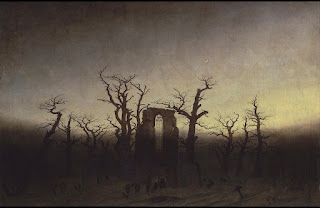Romantic Era

Romanticism is a type of art where the artist emphasized that sense and emotions - not simply reason and order - were equally important means of understanding and experiencing the world. Romanticism celebrated the individual imagination and intuition in the enduring search for individual rights and liberty. A popular technique that Romantic painters used was small, close strokes of complementary colors. “Abbey among Oak Trees, Caspar David Friedrich” Friedrich painted “Abbey among Oak Trees” in 1809 through 1810 in Dresden. This is an example of romanticism because you get the feeling of sadness and desolation. The sun is going down behind the horizon as fog emerges the ground. The dead trees rise above the fog and surrounds the crumbling ruins of a gothic abbey. A sense of terror overcomes the landscape as a funeral takes place. This painting captures many themes that are part of Romanticism. For example the color palette is muted tones of yellow and grey. I would absolutely ow
